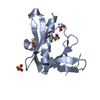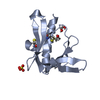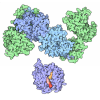Entry Database : PDB / ID : 9c66Title Structure of the Mena EVH1 domain bound to the polyproline segment of PTP1B Protein enabled homolog poly-proline segment of PTP1B Keywords / Function / homology Function Domain/homology Component
/ / / / / / / / / / / / / / / / / / / / / / / / / / / / / / / / / / / / / / / / / / / / / / / / / / / / / / / / / / / / / / / / / / / / / / / / / / / / / / / / / / / / / / / / / / / / / / / / / / / / / / / / / / / / / / / / / / / / / / / / / / / / / / / / / / / Biological species Homo sapiens (human)Method / / / Resolution : 1.4 Å Authors LaComb, L. / Fedorov, E. / Bonanno, J.B. / Almo, S.C. / Ghosh, A. Funding support Organization Grant number Country National Institutes of Health/National Cancer Institute (NIH/NCI)
Journal : Biochemistry / Year : 2024Title : Insights into the Interaction Landscape of the EVH1 Domain of Mena.Authors : LaComb, L. / Ghosh, A. / Bonanno, J.B. / Nilson, D.J. / Poppel, A.J. / Dada, L. / Cahill, S.M. / Maianti, J.P. / Kitamura, S. / Cowburn, D. / Almo, S.C. History Deposition Jun 7, 2024 Deposition site / Processing site Revision 1.0 Aug 28, 2024 Provider / Type Revision 1.1 Sep 11, 2024 Group / Category Item / _citation.page_first / _citation.page_lastRevision 1.2 Oct 23, 2024 Group / Category / pdbx_modification_feature / Item
Show all Show less
 Yorodumi
Yorodumi Open data
Open data Basic information
Basic information Components
Components Keywords
Keywords Function and homology information
Function and homology information Homo sapiens (human)
Homo sapiens (human) X-RAY DIFFRACTION /
X-RAY DIFFRACTION /  SYNCHROTRON /
SYNCHROTRON /  MOLECULAR REPLACEMENT / Resolution: 1.4 Å
MOLECULAR REPLACEMENT / Resolution: 1.4 Å  Authors
Authors United States, 1items
United States, 1items  Citation
Citation Journal: Biochemistry / Year: 2024
Journal: Biochemistry / Year: 2024 Structure visualization
Structure visualization Molmil
Molmil Jmol/JSmol
Jmol/JSmol Downloads & links
Downloads & links Download
Download 9c66.cif.gz
9c66.cif.gz PDBx/mmCIF format
PDBx/mmCIF format pdb9c66.ent.gz
pdb9c66.ent.gz PDB format
PDB format 9c66.json.gz
9c66.json.gz PDBx/mmJSON format
PDBx/mmJSON format Other downloads
Other downloads 9c66_validation.pdf.gz
9c66_validation.pdf.gz wwPDB validaton report
wwPDB validaton report 9c66_full_validation.pdf.gz
9c66_full_validation.pdf.gz 9c66_validation.xml.gz
9c66_validation.xml.gz 9c66_validation.cif.gz
9c66_validation.cif.gz https://data.pdbj.org/pub/pdb/validation_reports/c6/9c66
https://data.pdbj.org/pub/pdb/validation_reports/c6/9c66 ftp://data.pdbj.org/pub/pdb/validation_reports/c6/9c66
ftp://data.pdbj.org/pub/pdb/validation_reports/c6/9c66 F&H Search
F&H Search Links
Links Assembly
Assembly


 Components
Components Homo sapiens (human) / Gene: ENAH, MENA / Production host:
Homo sapiens (human) / Gene: ENAH, MENA / Production host: 
 Homo sapiens (human) / References: UniProt: P18031
Homo sapiens (human) / References: UniProt: P18031 X-RAY DIFFRACTION / Number of used crystals: 1
X-RAY DIFFRACTION / Number of used crystals: 1  Sample preparation
Sample preparation SYNCHROTRON / Site:
SYNCHROTRON / Site:  APS
APS  / Beamline: 31-ID / Wavelength: 0.97932 Å
/ Beamline: 31-ID / Wavelength: 0.97932 Å Processing
Processing MOLECULAR REPLACEMENT / Resolution: 1.4→19.83 Å / SU ML: 0.14 / Cross valid method: FREE R-VALUE / σ(F): 1.35 / Phase error: 20.05 / Stereochemistry target values: ML
MOLECULAR REPLACEMENT / Resolution: 1.4→19.83 Å / SU ML: 0.14 / Cross valid method: FREE R-VALUE / σ(F): 1.35 / Phase error: 20.05 / Stereochemistry target values: ML Movie
Movie Controller
Controller


 PDBj
PDBj


























